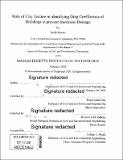| dc.contributor.author | Roxon, Jacob. | en_US |
| dc.contributor.other | Massachusetts Institute of Technology. Department of Civil and Environmental Engineering. | en_US |
| dc.date.accessioned | 2021-12-17T17:09:04Z | |
| dc.date.available | 2021-12-17T17:09:04Z | |
| dc.date.copyright | 2020 | en_US |
| dc.date.issued | 2020 | en_US |
| dc.identifier.uri | https://hdl.handle.net/1721.1/138526 | |
| dc.description | Thesis: Ph. D., Massachusetts Institute of Technology, Department of Civil and Environmental Engineering, February, 2020 | en_US |
| dc.description | Manuscript. "The images contained in this document are of the best quality available"--Disclaimer page. | en_US |
| dc.description | Includes bibliographical references (pages 131-145). | en_US |
| dc.description.abstract | Hurricane damage is one of the costliest and most frequent of natural disasters. In total, the cumulative cost of all 16 hurricanes in the US in 2017 was in excess of $300 billion and by 2075 the average annual damage cost in the US is expected to rise by nearly 40%. In order to mitigate disaster damage, governments mandate minimum standards for construction depending on location and building type--standards known as building codes. Yet most codes remain insufficient as they account only for individual buildings and overlook the influence of city layout on wind speeds and storm damage. To reinvigorate design codes and better predict hurricane damage, we propose a new city texture resilience approach, which accounts for local geometric layouts to predict more accurate building codes. Tested using computational fluid dynamics simulations for different city textures with common geometrical layouts, we found that the city texture model, derived using online GIS data of building footprints, predicts with 67% accuracy damage from 2018 Hurricane Michael in Mexico Beach, FL. Furthermore, we find that ordered "crystal" cites have higher susceptibility to hurricane damage showing higher proportion of buildings with upper range values of drag coefficients. Using this approach, stakeholders can readily identify entire cities (or neighborhoods) with high susceptibility to hurricane damage. Moreover, they can identify buildings with the highest risk of damage, which will offer targeted retrofitting, thereby enabling more resilient developments and urban planning to reduce the risk of hurricane damage and mitigate the kinds of extreme damage experienced by communities with histories of high speed winds, especially as climate change is going to intensify future storms. | en_US |
| dc.description.statementofresponsibility | by Jacob Roxon. | en_US |
| dc.format.extent | 149 pages | en_US |
| dc.language.iso | eng | en_US |
| dc.publisher | Massachusetts Institute of Technology | en_US |
| dc.rights | MIT theses may be protected by copyright. Please reuse MIT thesis content according to the MIT Libraries Permissions Policy, which is available through the URL provided. | en_US |
| dc.rights.uri | http://dspace.mit.edu/handle/1721.1/7582 | en_US |
| dc.subject | Civil and Environmental Engineering. | en_US |
| dc.title | Role of city texture in identifying drag coefficients of buildings to prevent hurricane damage | en_US |
| dc.type | Thesis | en_US |
| dc.description.degree | Ph. D. | en_US |
| dc.contributor.department | Massachusetts Institute of Technology. Department of Civil and Environmental Engineering | en_US |
| dc.identifier.oclc | 1281682312 | en_US |
| dc.description.collection | Ph. D. Massachusetts Institute of Technology, Department of Civil and Environmental Engineering | en_US |
| dspace.imported | 2021-12-17T17:09:04Z | en_US |
| mit.thesis.degree | Doctoral | en_US |
| mit.thesis.department | CivEng | en_US |
